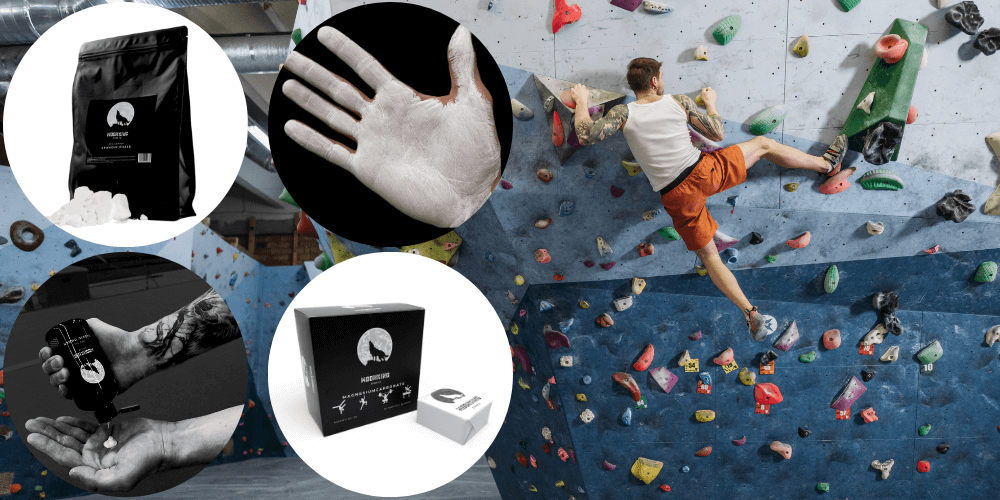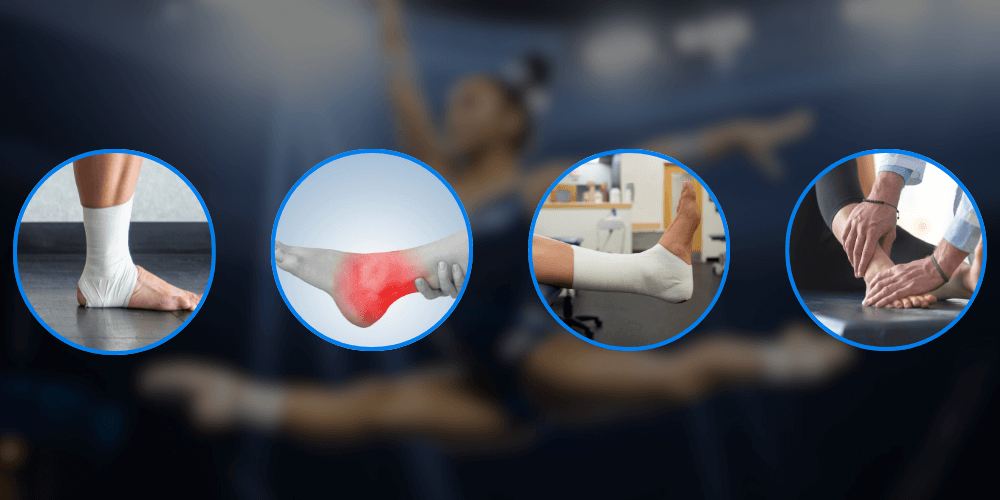Climbing and bouldering have enjoyed increasing popularity for years – whether indoors or outdoors. One of the key challenges in climbing is finding the optimal grip on the holds. This is where chalk (magnesia) comes into play. In this article, you'll learn how different types of chalk can help you improve your climbing and bouldering performance. We'll highlight the advantages and disadvantages of each type, draw on solid facts, and ultimately give you concrete recommendations on which chalk is best suited to your training or competition. You'll also learn why high-quality chalk should be your new companion for always having the perfect grip.
1. The role of chalk in climbing and bouldering
In climbing and bouldering, grip is important alongside technique, strength, and endurance – and this is where chalk (magnesia) plays a crucial role. Whether you're training indoors, climbing outdoors on a rock face, or want to demonstrate your skills in a bouldering gym, the correct use of chalk can significantly improve your performance.
Chalk helps absorb sweat from your hands, increasing grip, and optimizing contact between skin and grip. Without sufficiently dry hands, you not only tire more quickly but also run the risk of losing your grip—which can lead to injury. Therefore, choosing the right chalk is a fundamental decision for every climber and boulderer.
This comprehensive guide will tell you everything you need to know about chalk. We'll go into detail about the different types and highlight their pros and cons. Our goal is to help you find the ideal chalk for your needs, so you always have optimal grip during training and competition.
2. Why chalk is so important for climbers and boulderers
Sweat and grip
Climbing produces sweat, and that's not only unpleasant—it can drastically reduce grip. Even a slight increase in humidity or intense exertion will cause your hands to become wet. Without sufficient dryness, you'll quickly lose your grip, which can lead to slipping and, in the worst case, falls.
Psychological factors
Another aspect is the subjective feeling of safety. Many climbers report that they feel more confident with dry, grippy hands and are therefore able to climb more technically. Chalk therefore contributes not only physically but also mentally to performance.
Improved performance
Studies and field reports show that a well-dosed chalk application system—whether powder, liquid chalk, or chalk ball—significantly improves the friction between hand and grip. This leads to increased climbing performance, reduced fatigue, and an overall safer climbing experience.
3. The different types of chalk and their properties
We offer a wide range of chalk products specifically tailored to the needs of climbers and boulderers. We present the most important options:
3.1 Magnesia powder
What is magnesia powder?
Magnesia powder, often simply referred to as chalk, consists essentially of pure magnesium carbonate. It is the most classic form of chalk and comes in a fine, powdery consistency. When applied, the powder dries the hands by absorbing sweat and leaving a thin, dry layer.
Advantages:
- High yield: A small amount of powder is often enough to achieve the desired effect.
- Easy to use: Can be applied directly to the hands or spread using a chalk bag.
- Cost-effective: Usually cheaper than liquid chalk or chalk balls.
- Versatile: Ideal for climbers who need to adapt to different climbing walls and holds.
Disadvantages:
- Dust generation: Can lead to excessive dust generation, which can be problematic in indoor or communal training environments.
- Uncontrolled dosing: It is more difficult to apply a consistent amount of chalk, which can lead to uneven performance.
- Mess: Sprinkling loose powder can be messy and requires some cleaning of the hands after training.
3.2 Liquid Chalk
What is liquid chalk?
Liquid chalk is a liquid form of chalk that comes in a bottle. The formula typically contains a mixture of magnesium carbonate, alcohol, and thickeners. Upon application, the liquid dries quickly, leaving an even, dust-free layer on the hands.
Advantages:
- Less dust: Since it is applied in liquid form, hardly any dust is created – ideal for halls and indoor climbing.
- Even application: Allows controlled dosing and ensures consistent grip.
- Hygienic: Since it does not disperse into the air, the training area remains cleaner.
- Quick-drying: Usually dries within seconds, so you can get back to climbing quickly.
Disadvantages:
- Consumption: Liquid chalk can be used up faster if too much is applied.
- Initial effort: It may be a bit strange at first because it has a liquid consistency and feels different than conventional powder.
- Price: Often a bit more expensive than classic chalk powder.
3.3 Chalk Ball
What is a chalk ball?
A chalk ball is a container, usually in the shape of a ball or bag, containing loose chalk. Rubbing or squeezing the ball releases the chalk in a controlled amount. Chalk balls offer a good alternative for those who want more control over the dosage without the excessive dust of loose powder.
Advantages:
- Controlled release: Allows precise dosing by releasing only the required amount of chalk.
- Reusable: Many chalk balls are refillable, making them cost-effective in the long run.
- Less dust: Reduces the distribution of loose powder in the environment.
- Practical: Their compact format makes them easy to store in your chalk bag or on your belt.
Disadvantages:
- Handling: Some users find the handling more cumbersome than directly applying powder or liquid chalk.
- Cleaning: Can occasionally become messy if too much chalk is released at once.
- Cost: Refillable chalk balls are usually more expensive to purchase than disposable products.
3.4 Chalk Block
What is a chalk block?
A chalk block is a tightly pressed block of magnesium carbonate. This block shape is especially popular with competitors and professionals because it offers long-lasting durability and controlled application. The chalk is removed by rubbing it against your hands.
Advantages:
- Long durability: A single block can be used for a long period of time.
- Controlled application: Allows you to dose exactly the desired amount of chalk.
- Little dust: Similar to the Chalk Ball, less loose chalk is released into the air.
- Robust: Ideal for use in competitions where consistent quality is required.
Disadvantages:
- Limited application: The solid form requires a little more effort to apply and is less flexible than loose powder or liquid chalk.
- Unusual handling: Some climbers find the handling of a block unusual and prefer softer products.
- Price: High-quality chalk blocks can be more expensive because they are often intended for professional use.
4. Advantages and disadvantages of the individual chalk types at a glance
| Chalk art | Advantages | Disadvantages |
|---|---|---|
| Magnesia powder | - High yield - Cost-effective - Versatile |
- Excessive dust - Difficult dosage - Can be messy |
| Liquid Chalk | - Less dust - Even application - Hygienic - Quick-drying |
- Higher consumption - Somewhat unusual in use - More expensive |
| Chalk Ball | - Precise dosage - Reusable - Practical and compact - Less dust |
- Cumbersome handling - Cleaning can be time-consuming - Higher acquisition costs |
| Chalk Block | - Durable - Controlled application - Little dust - Robust for competition conditions |
- Limited flexibility - Unusual handling - Higher price |
Choosing the right chalk depends largely on your individual needs. While loose chalk powder is ideal for climbers who prefer quick and flexible application, liquid chalk and chalk balls offer cleaner and more controlled application – especially in gyms where excessive dust can be problematic. Chalk blocks are particularly suitable for competition environments where consistency and durability are required.
5. Important factors for climbing and bouldering performance
5.1 Grip and moisture control
The main function of chalk is to improve grip . Dry hands mean:
- Less slipping: Chalk absorbs sweat and thus reduces the risk of hands slipping.
- Better connection to the handle: A dry contact ensures more friction between the hand and the handle.
- Improved concentration: When you don't have to constantly deal with wet hands, you can fully concentrate on your technique and movement.
5.2 Application and shelf life
- Fast drying: Especially during competitions or intensive training, it's important that the chalk dries quickly and works immediately. Liquid chalk scores points here because it dries within seconds.
- Long-lasting effect: If you have longer bouldering sessions, the chalk needs to retain its effect throughout. Products like chalk balls and chalk blocks play a role here, as they allow for a continuous and controlled release.
5.3 Consistency and dosage
The ability to apply chalk in an even layer is crucial for many climbers. A layer that's too thin doesn't provide enough grip, while too much chalk leads to uncontrolled dust formation:
- Magnesia powder: Can be distributed unevenly.
- Liquid Chalk: Provides consistent and controlled application.
- Chalk Ball: Allows precise dosing and reduces waste.
- Chalk Block: Ensures an even but less flexible application.
6. Scientific background and facts on the use of chalk
Studies and findings
Numerous studies and reports from the climbing community demonstrate that dry hands have a significant impact on climbing performance. Some scientific findings include:
- Increased friction: Studies show that the use of magnesium carbonate can increase friction between the skin and the surface by up to 30%. This leads to a better grip on the handlebars.
- Reduction of fatigue: Dry hands reduce the energy required to hold the body on the grip – which is especially beneficial on longer routes.
- Psychological factors: Sports psychology studies confirm that climbers with dry hands have greater self-confidence, which has a positive effect on the execution of climbing movements.
Practical experience
Experienced climbers and boulderers report significantly improved performance after switching from loose chalk to liquid chalk or chalk balls. In addition to the physical effect, improved handling and dosage also play an important role.
7. Tips for the optimal use of chalk in training and competition
Before training:
- Preparation: Clean your hands thoroughly so that the chalk can spread optimally.
- Practice dosage: Experiment with different types of chalk to find out which amount and which type suits you best.
- Warm-up: A short warm-up program promotes blood circulation and optimally prepares the skin.
During training:
- Re-cool regularly: Reapply the chalk regularly to keep your hands dry – especially during intense sessions.
- Correct technique: Check your climbing technique to optimize chalk consumption and avoid unnecessary use.
- Efficient use: Use the chalk specifically on the areas that need the most grip, such as fingertips and palms.
After training:
- Cleaning: Wash your hands thoroughly to remove residue and avoid skin irritation.
- Repurchase: Make sure you always have enough chalk available – our products offer a wide selection.
- Exchange: Exchange ideas with other climbers to learn from their experiences and find the best way to use chalk.
8. Conclusion: Which chalk is right for you?
Choosing the right chalk depends largely on your individual needs:
-
Magnesia powder:
Ideal for: Climbers who want a quick, flexible application and want to stay cost-effective.
Advantages: High yield, versatile, inexpensive.
Disadvantages: Can produce too much dust, uneven dosing. -
Liquid Chalk:
Ideal for: Climbers and boulderers who train indoors or prefer a clean, consistent application.
Advantages: Fast drying, minimal dust, controlled dosage.
Disadvantages: Higher consumption, somewhat unusual in use, more expensive. -
Chalk Ball:
Ideal for: Climbers who value precise dosing and reusability.
Advantages: Precise dosing, environmentally friendly, practical.
Disadvantages: Inconvenient handling, slightly higher purchase price. -
Chalk Block:
Ideal for: Competition environments and professional climbers who value consistency and durability.
Advantages: Durable, controlled application, low dust.
Disadvantages: Less flexible in use, takes some getting used to, more expensive.
For everyday indoor use , liquid chalk is often the best choice, as it allows for clean and even application without contaminating the training area with loose powder. In competition environments where consistency and durability are crucial, however, a chalk block may be the optimal option. For those who value precise dosing and reusability, a chalk ball is ideal.
We offer all of these options in the highest quality – perfectly tailored to the needs of climbers and boulderers. This way, you can be sure you're choosing the right chalk for your training and competition, and continuously improving your performance.
9. Conclusion
In summary, chalk (magnesia) is an indispensable companion for every climber and boulderer. It not only improves grip and reduces sweat, but also boosts your confidence and overall performance. Whether you choose classic magnesia powder, liquid chalk, a chalk ball, or a chalk block, each option has its own advantages and disadvantages.
Now it's time to maximize your climbing performance:
Take your time to browse our website, explore our wide selection, and find the perfect chalk that meets your needs. Order today and embark on a new level of climbing and bouldering performance. Don't miss the chance to optimize your grip and take your training to the next level!
This guide provides you with detailed information, solid facts, and practical tips to help you find the optimal chalk solution for your climbing and bouldering training. We hope you're now well-informed and can make the ideal choice for you – so every hold is perfect and you can climb safely and successfully. Happy climbing – and always keep a firm grip!
Act now:
Experience how our high-quality chalk can improve your climbing performance – visit MoonKing Sports and find your perfect product today!









